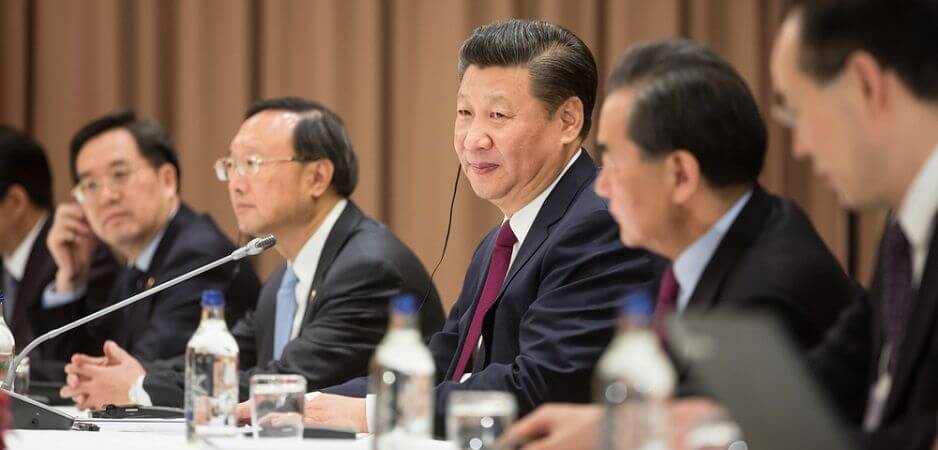After consolidating power at the recent party congress, a key question is whether Xi Jinping, facing large debts, will follow Deng Xiaoping’s path and open up China’s economy more.
China’s twice-a-decade Communist Party congress wrapped up on October 26 with party head and President Xi Jinping claiming a place alongside revolutionary leader Mao Tse-tung in the pantheon of modern Chinese heroes. In addressing the congress, Xi focused on contradictions the party faces in steering China toward a brighter future, much as Mao highlighted “class contradictions” decades earlier.
But the party gathering did little to clarify how the leadership plans to handle the challenges simmering within the world’s second-largest economy, and especially within its chaotic financial system.
Franklin Allen, an emeritus Wharton professor of finance, and a professor of finance and economics at Imperial College in London, questions Xi’s appetite for painful reforms that are needed to rebalance China’s economy away from its longtime heavy reliance on construction investment and exports. “Xi has established tremendous political power. Now the question is how much of that he will turn into economic reforms,” Allen says. For now, Xi seems to prefer using his “One Belt, One Road Initiative,” to expand Chinese supply chains and market access, as well as its geopolitical influence, across the developing world. In the meantime, on the domestic front, “I would not be surprised if there was slow and gradual reform.”
The outlook for reforming China’s developing financial markets and the banking system remains obscured, in part, by a lag in the timing for key appointments such as a successor for Zhou Xiaochuan, longtime head of the People’s Bank of China. Some newly appointed party leaders, including Xi’s close economic adviser Liu He, are thought to support more market-oriented reforms.
Will Financial Reforms Be Smothered?
But the overall tone of the congress in backing stronger Communist Party involvement in the economy and businesses is worrying some longtime China watchers. “I am fearful that the party conservatives will prevail over the economic and financial reformers after the party congress,” says Pieter Bottelier, a visiting scholar of China studies at Johns Hopkins School of Advanced International Studies (SAIS) in Washington, DC.
He sees a direct conflict between the party’s priorities and those favoring more aggressive financial reforms. Xi’s landmark three-hour speech at the outset of the congress “showed the top priority of the party is no longer economic development and growth, but consolidation of the party power, party prestige and party control of everything,” Bottelier says.
With the economy still growing at an annual pace of over 6% and financial markets seemingly on an even keel, Xi’s team can claim to have weathered the post-2008 financial crisis with few major hiccups. But rising levels of corporate, banking and government debt have prompted the International Monetary Fund to raise the alarm. Estimates of the ratio of non-performing loans to total lending in the banking sector range as high as 35%. Most economists and banking analysts say the real level is likely much lower.
China has seen worse: In the late 1990s, many of the biggest banks were technically insolvent, buried in mountains of debt from many years of financing defunct state-owned enterprises (SOEs). The government successfully rescued most of the banks, shifting the unrepayable loans into asset management companies and recapitalizing the banks. If need be, it can do it again, analysts say. But such bailouts only treat the symptoms of deeper dysfunctions within the economy that will hinder economic growth as the economy matures.
Why Such High Debt?
To understand the urgency of the problem it’s necessary to grasp why debt levels are so high and are rising so rapidly, what the risks are of failing to resolve the issues, and what unexpected triggers could unleash a wider, more damaging financial crisis with potential global implications.
“A lot of people see the debt itself as the problem. I see the debt more as the symptom of the deeper underlying problem which is misallocation of credit and resources,” says Julian Evans-Pritchard, China economist for Capital Economics. In other words, money is going not to the best opportunities with the greatest potential returns, but to the state-owned companies or government projects with the strongest political leverage. “The reason for that is the role of the state in the economy and the large role of the state sector in many parts of the economy.”
The level of debt in the Chinese economy skyrocketed after Beijing unleashed record amounts of stimulus — at least 17.5 trillion yuan ($2.6 trillion) — to help fend off the worst impact of the 2008 financial crisis. That credit binge has not yet been fully digested. In the years since, the level of debt surged further, much of it as “off balance sheet” lending by so-called shadow banks that operate outside the state-dominated formal banking industry.
 The shadow banks play a key role in directing financing to China’s dynamic and fast-growing private sector. Such companies are the real driving force behind the country’s ascent as a global trading power and are the main creators of jobs, but are generally shunned by the state banks, which exist mainly to funnel support to state-owned enterprises.
The shadow banks play a key role in directing financing to China’s dynamic and fast-growing private sector. Such companies are the real driving force behind the country’s ascent as a global trading power and are the main creators of jobs, but are generally shunned by the state banks, which exist mainly to funnel support to state-owned enterprises.
Moody’s Investor Service estimates that the size of shadow bank lending has more than doubled since 2012, growing more than 20% in 2016 to reach 64 trillion yuan ($10 trillion), or about 86.5% of China’s GDP. The category spans a wide array of funding sources, including wealth management products, entrusted loans, finance company loans, pawn shop loans, online peer-to-peer lending, consumer credit companies and microcredit, among others.
The IMF estimates that risky corporate loans amount to 15.5% of total corporate loans of Chinese commercial banks. CLSA, a brokerage and investment group, put the non-performing loan (NPL) ratio at 15-20% in 2016. The official government figure was 1.74% at the end of June 2017, unchanged from March. The wider figure for total NPLs plus “special mention” loans that are vulnerable to adverse economic conditions but still being repaid was 3.64% as of the end of June, according to the China Banking Regulatory Commission.
Louis Kuijs, a China expert and head of Asia Economics at Oxford Economics, estimates the level of problem loans including bank loans, shadow banking lending, and local and central debt at about 14% of China’s GDP.
But estimates of the total amount of debt in the economy go much higher, up to 280% of GDP as of the end of 2016, says Evans-Pritchard. The ratio of debt to GDP has improved recently thanks to a pickup in economic growth fueled by still more stimulus that has fired up property prices and other asset prices. But it’s bound to deteriorate again as activity slows. “We figure debt levels are high. Not only are they high, but the main thing that is concerning is how quickly they’ve risen,” he says.
Under Xi, the government has sought to curb the shadow banking that is a big share of debt and a potential source of financial instability given its tenuous access to funding and lack of regulation. The balance of outstanding wealth management products amounted to 30.1 trillion ($4.5 trillion) yuan, or nearly half of the 64 trillion yuan in total shadow bank loans, at the end of 2016. It had declined by 10% by the end of August 2017 from the end of 2016, according to Fitch Ratings. In late September, the CBRC re-emphasized its determination to tackle the problem, warning that failure to spot and deal with problems would be viewed as a dereliction of duty, Fitch Ratings said in a research note.
Chi Lo, a senior economist at BNP Paribas Investment Partners in Hong Kong and author of several books on China, estimates the share of shadow banking finance in the Chinese system fell from a peak of 37% in 2013 to less than 10% at the end of 2016. But instead of eliminating this murky segment of the financial sector, Beijing needs to regulate it, he says. Evans-Pritchard adds that cracking down on shadow banks helps reduce risks but conversely hurts a trend toward improved allocation of credit, because it cuts off smaller corporate borrowers that have no other source of financing. “Many of these smaller firms have much higher returns on assets. They’re much more efficient than the larger SOEs. It’s not necessarily a positive for credit allocation,” he says.
Minyuan Zhao, a Wharton professor of management, notes: “[C]leaning up shadow banking is not easy. With economic slowdown, firms, especially small and medium-sized firms, are facing serious financial crunches. Meanwhile, with a disappointing stock market and restrictions on outward financial investment, investors are looking everywhere for higher returns. Without serious reforms, the official banking sector simply does not have the means (or flexibility) to bridge the two sides, although they are sometimes enablers of shadow banking.”
Even if they can count on the government to step in if debts spiral out of control, China’s bigger and more powerful state commercial banks are facing risks of their own. Increasingly, the banks are relying on short-term funding and interbank funding. Growing interdependence between the banks adds to the potential risks from any liquidity crisis, which could ripple throughout the industry and beyond. With growing portfolios of non-performing loans on their books, the profitability of most of the banks is declining, and that erodes their capital bases. Ultimately, the banks may need to turn to the government. Regulators, aware of this trend, are pushing for more “market discipline” in the form of using debt-equity swaps and loan securitization to avoid outright bailouts.
Risks of Crisis Remain
For now, economists are downplaying the likelihood of an immediate crisis. “The banks are taking a gradual approach to the NPL problem by writing them off from their balance sheets or transferring some to asset management companies,” says Rajiv Biswas, Asia Pacific chief economist for IHS Markit. It’s unclear just how long the banks can carry on with such strategies before they will end up having to seek help from the regulators.
In the meantime, Xi’s China must grapple with those contradictions, between state control and market forces; excess supply in many industries — from steel and aluminum to rubber flip-flops and plastic trinkets — and volatile demand; and the tradeoffs between quantity versus quality of growth. So far, the signals from the congress point to an emphasis on continuity and caution.
“The choices are stark. Either they allow distressed large SOEs to fail or reform the SOEs so they operate on a commercial basis. So far there has been willingness to do neither,” notes Marshall Meyer, a Wharton emeritus professor of management.
The government remains committed to its goal of doubling the GDP of 2010 by 2020. Xi’s call to promote Made in China “national champions” and prevent losses of state assets indicated a commitment to protecting the state sector, not to overhauling it to improve its productivity.
Given the huge and to a certain extent hidden amount of debt within the economy, China’s regulators are gambling they can take their time in tackling the problems in the banking sector.
Property prices in the biggest cities, such as Beijing and Shanghai, have risen higher than in the U.S. and even Japan. “If you get a sharp and sustained decline in real estate prices, you will have a whale of problem,” says Bottelier. Much of the local government and corporate debt is tied up in the real estate sector. If prices fall, and they will eventually, “the NPL ratio will shoot up because borrower after borrower will not be able to meet debt payments at much lower real estate prices.”
Wharton’s Zhao adds: “As of now, most banks in China are not losing sleep because of NPLs. The booming (or bubbly) housing market is propping up a major part of bank assets, and contributed to the high profits some banks enjoyed in the past year or so. Many believe this is not sustainable. Given that the state banks are held hostage by the real estate sector, the government will not easily pop the housing bubble. Instead, it is encouraging the development of rental properties to isolate ownership from affordability issues.”
Meyer points out that “everyone used to say the debt wasn’t serious because it was domestic — it’s not like 1997 when foreign investors pulled out of the Tiger countries leaving behind debt denominated in dollars. Still, there are lots of warnings about local government and SOE debt. Last month, Zhao Xiaochuan warned of a possible Minsky moment [a sudden loss of confidence leading to a financial crisis]. In September, S&P downgraded China.”
No “Cold Turkey”
There is no “cold turkey” solution to the debt bubble in China, and China’s regulators will do well to tread carefully as they restore balance to the financial sector, says Chi Lo. Credit growth has been outpacing economic growth for over a decade. A sharp cutback would “crush the economy before the benefits of deleveraging could materialize,” he says. A better option is to use a variety of strategies such as the restructuring of zombie companies, bankruptcies, debt defaults and local austerity measures.
With such a gradual approach, China may manage to avoid the sort of deflationary slump that Japan slipped into when its bubble economy imploded in the early 1990s, ushering in its current era of glacial-paced growth. At the same time, Chinese regulators need to find ways to correct the imbalances and misallocations in credit and other resources that are hindering strong domestic consumption-fueled growth.
Whether they will choose to do so remains unclear: The track record is not encouraging given both the signals from above, and the graft and influence peddling that pervades the economy. Tightening the taps on credit carries risks of its own. “It’s not clear at this stage what the pain threshold is and how willing they are to allow growth to slow,” says Evans-Pritchard of Capital Economics. “I see big tensions in their goals.”
To claim a place alongside Mao and Deng Xiaoping, who initiated the current era of “opening up” China to world markets, Xi needs to go beyond what was promised at the party congress, says Allen. “Xi has followed Mao so far by gaining strong political control. Is he going to do what Deng did to open up China and let the markets decide? If he does, China can grow even faster.”
*[This article was originally published by Knowledge@Wharton, a partner institution of Fair Observer.]
The views expressed in this article are the author’s own and do not necessarily reflect Fair Observer’s editorial policy.
Photo Credit: Drop of Light / Shutterstock.com
Support Fair Observer
We rely on your support for our independence, diversity and quality.
For more than 10 years, Fair Observer has been free, fair and independent. No billionaire owns us, no advertisers control us. We are a reader-supported nonprofit. Unlike many other publications, we keep our content free for readers regardless of where they live or whether they can afford to pay. We have no paywalls and no ads.
In the post-truth era of fake news, echo chambers and filter bubbles, we publish a plurality of perspectives from around the world. Anyone can publish with us, but everyone goes through a rigorous editorial process. So, you get fact-checked, well-reasoned content instead of noise.
We publish 2,500+ voices from 90+ countries. We also conduct education and training programs
on subjects ranging from digital media and journalism to writing and critical thinking. This
doesn’t come cheap. Servers, editors, trainers and web developers cost
money.
Please consider supporting us on a regular basis as a recurring donor or a
sustaining member.
Will you support FO’s journalism?
We rely on your support for our independence, diversity and quality.






